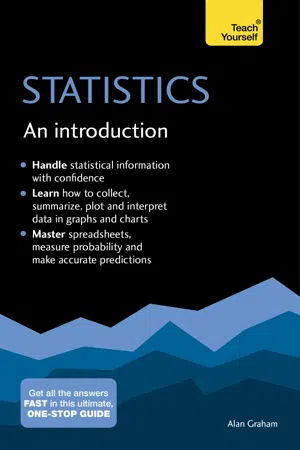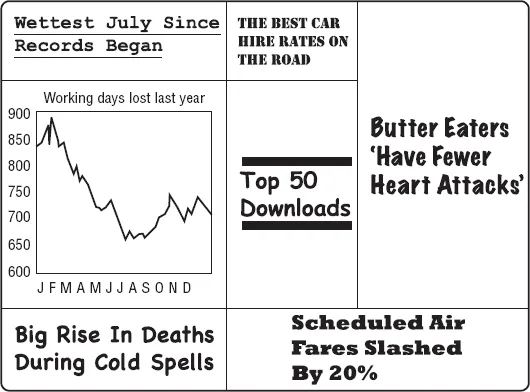
eBook - ePub
Statistics: An Introduction: Teach Yourself
The Easy Way to Learn Stats
Alan Graham
This is a test
Share book
- 320 pages
- English
- ePUB (mobile friendly)
- Available on iOS & Android
eBook - ePub
Statistics: An Introduction: Teach Yourself
The Easy Way to Learn Stats
Alan Graham
Book details
Book preview
Table of contents
Citations
About This Book
Do you need to gain confidence with handling numbers and formulae? Do you want a clear, step-by-step guide to the key concepts and principles of statistics? Nearly all aspects of our lives can be subject to statistical analysis. Statistics: An Introduction shows you how to interpret, analyze and present figures.Assuming minimal knowledge of maths and using examples from a wide variety of everyday contexts, this book makes often complex concepts and techniques easy to get to grips with. This new edition has been fully updated.Whether you want to understand the statistics that you are bombarded with every day or are a student or professional coming to statistics from a wide range of disciplines, Statistics: An Introduction covers it all.
Frequently asked questions
How do I cancel my subscription?
Can/how do I download books?
At the moment all of our mobile-responsive ePub books are available to download via the app. Most of our PDFs are also available to download and we're working on making the final remaining ones downloadable now. Learn more here.
What is the difference between the pricing plans?
Both plans give you full access to the library and all of Perlego’s features. The only differences are the price and subscription period: With the annual plan you’ll save around 30% compared to 12 months on the monthly plan.
What is Perlego?
We are an online textbook subscription service, where you can get access to an entire online library for less than the price of a single book per month. With over 1 million books across 1000+ topics, we’ve got you covered! Learn more here.
Do you support text-to-speech?
Look out for the read-aloud symbol on your next book to see if you can listen to it. The read-aloud tool reads text aloud for you, highlighting the text as it is being read. You can pause it, speed it up and slow it down. Learn more here.
Is Statistics: An Introduction: Teach Yourself an online PDF/ePUB?
Yes, you can access Statistics: An Introduction: Teach Yourself by Alan Graham in PDF and/or ePUB format, as well as other popular books in Volkswirtschaftslehre & Statistik für Volks- & Betriebswirtschaft. We have over one million books available in our catalogue for you to explore.
Information
1
Introducing statistics

In this chapter you will learn:
• why learning about statistics might be a worthwhile thing to do
• about some everyday situations where having a better statistical understanding might be useful to you
• what sort of questions might be seen as ‘statistical’ questions
• whether it might help to use a calculator.

Some good reasons to learn about statistics
Statistics are all around us – in newspapers, on television, in general conversation with friends. Here are a few typical examples of headlines, graphs and advertisements that you might easily find in a daily newspaper or online.

Although it may not yet be immediately obvious to you, each of these examples embodies an important idea in statistics. They suggest just a few of the choices that we make all the time, with or without an understanding of statistical ideas. An underlying aim of this book is to suggest to you that statistics isn’t just something you learn about from a textbook, but it can actually change the way you see the world and inform your judgements. There are a number of more specific reasons why it makes sense to have a basic grasp of statistics. Below are listed just some of them.
• As these examples suggest, much of the information we have to process in our different life roles – at home, as consumers, at work, in the community and as citizens in a wider economic and political setting – comes in the form of numbers, graphs and charts. A statistical awareness helps us to understand the forces acting on us and to process the information that confronts us, particularly when it is being used in a deliberately misleading way.
• Many of the important decisions that we have to make involve handling numbers and weighing up risks. A knowledge of statistics and probability won’t guarantee that you always make the correct decision, but at least your decisions should be better informed.
• From archaeology to zoology, almost every subject covered at school, college or in the media has become increasingly quantitative, so it is becoming ever harder to hide from the need to have a basic understanding of statistics. This is particularly true of business.
• Statistics can be enjoyable – see how you feel about this idea by the time you have finished this book!
Statistics in everyday life
It seems that there is no escape from statistics! Increasingly, a statistical awareness is an essential requirement of the workplace. For the majority of people, a day in work will include some time spent processing and interpreting information in the form of numbers, percentages, tables, graphs or diagrams.
But even outside the world of work, statistical and mathematical skills are an essential part of being a functioning adult, whether you are listening to the radio, watching television, reading a newspaper or magazine, cooking a meal, following an instruction manual, assembling furniture, checking train times, ordering concert tickets, ordering weekly food shop, filing tax return online…The list goes on and on.
When engaging in these sorts of everyday events, you are probably never fully conscious of the statistical thinking that you are using. But sometimes it is valuable to make your thinking explicit, if only to be aware of your own strengths and weaknesses and discover where you might need to brush up your skills and understanding. Below are just two particular areas where most of us could do with a bit of a brush up: handling very small and very large numbers and evaluating risk.
SMALL AND BIG NUMBERS
For most people, the sort of information that they handle on a day-to-day basis tends to involve whole numbers in the range 0 to 1000. For example, in a typical week you will certainly bump into the numbers 12 (the hours on a clock face), 30 (speed restrictions in miles per hour), 180 (playing darts or setting the oven temperature) and so on. And if you are a sports fan, numbers in the form of scores, times and distances will come at you in a constant stream. However, our exposure to very small numbers such as 9.1094 × 10−31 (the mass of an electron at rest in kg) or big numbers such as 299 792 (the speed of light in km per second) is much rarer. As a result, most people are not good at handling these sorts of numbers with confidence, and indeed human intuition is often flawed in situations where very small or very large numbers are involved. For example, the estimates of the number of people attending a public demonstration, football match or concert will vary enormously from one person to another. If you want to improve your number processing skills, try thinking up, in an idle moment, some questions to ponder similar to those shown below. Then try resolving them using rough, common-sense estimates and simple calculations (a calculator will help with any awkward numbers).
| Questions to ponder | Resolution (rough approximates only) |
| How fast, in kilometres per hour, does human hair/human fingernails grow? | When I have my monthly haircut, on average, about 2 cm is trimmed off. Using 30 days per month and 24 hours per day, this works out at roughly 2 ÷ 30 ÷ 24 = 0.0028 cm/h, or 0.0028 ÷ 100 ÷ 1000 = 0.000 000 028 km/h. |
| Roughly how many cigarettes are smoked annually in the UK? | If roughly one adult in six in the UK smokes, that is about 8 million people. Assume that the average consumption of cigarettes among smokers is around 10 per day. Then the total number of cigarettes smoked annually is 8 million × 10 × 365 or roughly 30 billion. |
| Could you fit the entire population of the world on the Isle of Wight? | It will help to know that the approximate area of the Isle of Wight is 380 km2 (or about 147 square miles). If we assume that everyone is standing up, you might fit four people into each square metre. There are 1 million square metres in one square kilometre, so the total number of people that could be accommodated is 380 × 1 000 000 × 4 or roughly 1.5 billion people. This is only just over 20% of the current population of the world, so it would seem to be theoretically impossible, although in practice I doubt if everyone would accept the invitation to try anyway! |
 | Nugget: scientific notation |
You may have spotted earlier the rather odd-looking number, 9.1094 × 10−31. It may not have been obvious to you that this is an extremely tiny number. In fact this is a number so tiny it would be difficult to write out using conventional decimal notation. In fields such as science and astronomy, very large and very small numbers crop up often. In order to write them down clearly, an alternative notation has been devised called scientific notation (also known as standard form). Here is a simple example of scientific notation.
The number 2 × 103 means 2 with three zeros after it, or in other words 2000. The number 5 × 104 means 5 with four zeros after it, or in other words 50 000. In order to describe a tiny number less than 1, we use negative powers of 10. So 7 × 10−2 means 7 divided by 102 and is equivalent to 0.07. The number 6 × 10−5 means 6 divided by 105 and is equivalent to 0.000 06.
